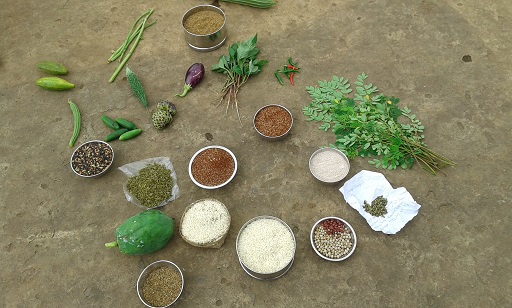
At 4.45pm in the evening, the quite village of Langi set in the foothills of Niyamgiri Mountains in Rayagada district of Odisha, was busy with women returning from the agriculture fields. Little girls, still in their school uniforms, were organizing the kitchen to help their mothers cook the evening meal. The Kond tribes inhabit the Niyamgiri mountain regions of Odisha and typically the women are the hardest working.
It was a sultry afternoon and men lazed around smoking the local cigars and waiting for their wives to come back from work and cook the evening meal. In the midst of all this Nivas the community worker was running around to remind everyone that a meeting had been scheduled for the day at the village school. The men were aware about this meeting and gathered gradually bringing with them little portions of raw food from their homes.
One by one nearly 22 variety of cereals, leafy vegetables, millets, pulses, oil seeds and vegetables were collected. There would be a discussion on food groups and local dietary habits today and they had planned that they would bring the food for discussion. The men were the first to gather. As the evening progressed dark hanging clouds burst in to heavy showers, but this did not deter the women who slowly came up to join the meeting covering their heads with big leaves, umbrellas and the local hats called jaki, even after the hard long day at the fields and forests.
Nivas explained that the food we eat give us energy to work, build our bodies and also protect us from diseases, without food none of these are possible. Men & women nodded in agreement and added that during times of hunger there is more illness and the body feels too weak to work. It was important to understand which food does what, so Nivas arranged the food based of their roles and in very simple terms explained “the 3 colours of the India Flag will remind us of the food groups ‘the white are the energy giving food’ ‘the red & orange are the body building foods’ and ‘the green foods protect the body from infections”. This made the food groups sound very simple and convinced the listeners. They listened with great interest and tried out planning the daily meal with the inclusion of at least one item from each group.

This is where Budu Patika the middle aged man asked “but how will we get so many varieties throughout the year?” The diet of the kond tribes are based mostly on the cereals and millets. They are very hard working and require large amounts of energy giving foods, fulfilling the needs only from rice is too expensive, so they eat the rice with a gruel of millets. Vegetables form a very small part of the meal. Proteins nearly don’t exist. Though chickens and goats are part of the household these are either eaten during festivals or sold in the markets. They believe that the calf has the right to the cow’s milk and only occasionally do they feed cow milk to their own children. So animal protein is almost nonexistent in their diets although they are not vegetarians.
Now was the time for planning action. Niwas asked “then what shall we do? Shall we continue eating only white foods?” Sunamani Urlaka, the 51 year old lady was listening quietly all this while. Now she spoke up, she said “we have to do something”, she shared “during the lean periods we used to grow some millets and vegetable, but due to the careless grazing we could not save the crops. Over the years the crops ceased to exists”. Sunamani added “now that we have realized we will plan our grazing and crops so that there are 3 food groups available throughout the year”. The community, with the support from Niwas made some important plans to improve the household dietary diversity, these included: – ensuring 3 varieties of food in daily diet with appropriate quantity of oil, protection of forest for ensuring availability of Uncultivated food, stopping open grazing during harvest of some important millet from November onwards and millet varieties like fox tail millet, barnyard millet, little millet will be revived by some farmers this year, then others will also cultivate it from next year. It was decided that the topic of the meeting for October would be on open grazing.
However simple the process may appear, this was a very critical decision that was facilitated by Niwas and taken up by the villagers of Langi. It will not only change their age old cultures but also the livelihoods, still they were determined to change to improve the nutrition & well being of their children, women and family at large.
The lives of Budu, Sunamani and many other is going through a process of evolution, thanks to the Linking Agriculture Natural Resources and Nutrition (LANN) Participatory Learning and Action (PLA) meetings that have been initiated in the 100 remote villages of Bissam Cuttack & Muniguda by Living Farms. There are villages which have shifted completely from growing cash crops like BT Cotton to growing pulses which serves both as food as well as livelihoods.




